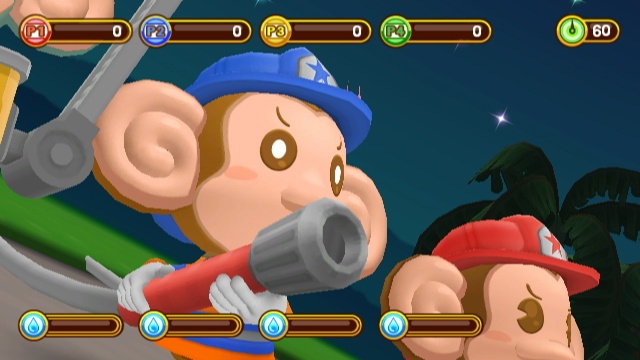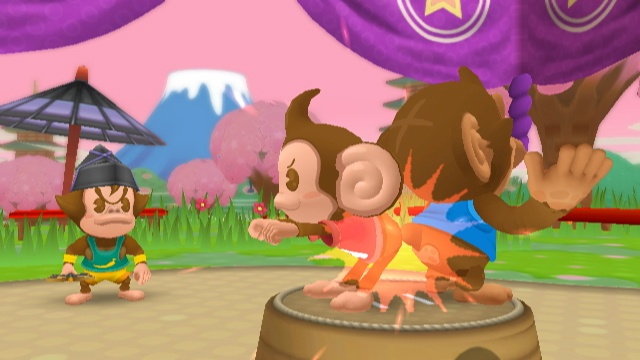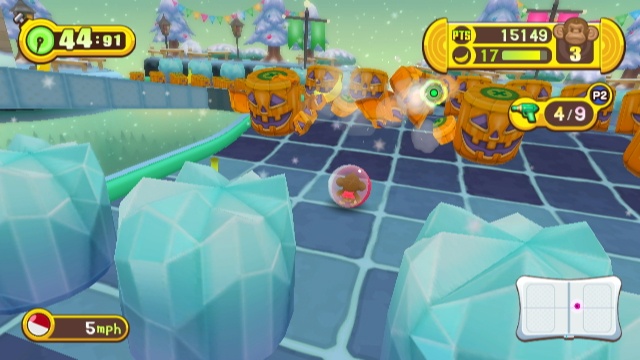Super Monkey Ball: Step and Roll Updated Hands-On Impressions
We monkey around with the new control scheme and find out just how hard it really is to roll a ball in Super Monkey Ball: Step and Roll.
It must be tough to have to constantly find ways of breathing new life into an old franchise, but Sega appears to be doing an admirable job with Super Monkey Ball. While the core experience has not changed with this latest instalment, the new control scheme using the Wii Balance Board in Step and Roll adds a different and immersive gameplay element that could see this old party game bounce back to life. We had a chance to try out the Wii Balance Board support in a recent hands-on session with Super Monkey Ball: Step and Roll, rolling our way through the game’s first three worlds and some of the new minigames.
For those unfamiliar with previous Monkey Ball games, the aim of the game is to roll the monkey ball around different stages and collect as many bananas as possible. In Step and Roll, there are 10 worlds, each made up of 10 different stages that increase in difficulty. The challenge is to navigate around each of the stages and make it to the finish marker before the 60-second timer runs out. We began with a tutorial stage in World 1 (Monkey Island), where we were introduced to the game’s new control scheme. During a recent interview with GameSpot, Super Monkey Ball: Step and Roll producer Yasuhito Baba revealed that the development team wanted to find a new way for players to experience Super Monkey Ball in order to increase the “party feel” of the title. The solution was the introduction of the Wii Balance Board, which allows a player to use his or her whole body to control the rolling primate ball. Like the gameplay, the new control scheme is relatively simple to master: You simply stand on the Wii Balance board and shift your weight forward, backward, and left or right to control the direction of the monkey ball.
While the first few stages proved a cinch because of the simple level design (a straight line from start to finish), the game was quick to turn up the heat. Each stage is designed to be a little more difficult than the last--tighter turns, more obstacles, more navigational puzzles, and more uneven terrain. Taking on these stages with a controller is one thing; relying on your centre of balance and coordination skills to navigate your way around them is quite another. We quickly realised this in one of the later stages in World 1, when we had to roll the monkey ball across a platform that was in continual motion--like a seesaw. To do this successfully, we had to perform a series of very exact body movements in quick succession at the right moments. Failing to get any one of these elements right meant the monkey ball rolled in the wrong direction.
We also found that the game’s controls were rather sensitive--a slight lean to the left or right would send the monkey ball careering out of bounds, while leaning forward would see the ball pick up an incredible amount of speed very quickly. Mastering this control scheme will certainly take some time, unless you happen to already be an expert at finding and keeping your centre of gravity. However, you don’t have to use the balance board. You can play the game using the Wii Remote, which proves more intuitive and a lot easier to control. It’s still a matter of pointing the Wii Remote at the screen and twisting your arm left or right then tilting it forward to accelerate or backwards to brake, but it's certainly more precise than using your whole body. Using the Wii Remote also eliminates the problem of nausea (to a degree). Throughout the game, the screen moves with the direction of the monkey ball, spelling trouble for those who are already finding it tough maneuvering the ball through the myriad of twists and turns. We advise caution: When you feel your stomach lurching, it's time to stop.
We kept playing through World 2 (Excavation Site) and World 3 (Chimpan Sea), which proved more of the same. One thing we noticed was that the puzzle stages began to get a lot harder: For example, in some cases, you will not be able to clear a stage without collecting all the bananas. However, if you run out of time, you can go back and try again because once bananas have been collected, they will not reappear.
The balance board seems better suited to the 21 minigames in Step and Roll. We tried out a few, including Monkey Race, in which you race your monkey ball along a race track against other monkey balls. This adapts to the balance board control scheme very easily--there are no violent twists or turns and the track is relatively smooth. Using your body to navigate the ball and pick up speed comes with no effort at all. And, it's actually a lot of fun. Similarly, one of the new minigames uses a hilarious humping action (seriously) in which players must use their hips to "bump" their opponents out of a ring. An even better example of the balance board is a minigame called Fireman, where players use the Wii Remote to point to a series of fires on the screen and use the balance board to pump water on the fires.
At this stage, Super Monkey Ball: Step and Roll is looking like a fun, albeit difficult, addition to the monkey-in-a-ball franchise, and we look forward to seeing more of the game in the coming months.
Got a news tip or want to contact us directly? Email news@gamespot.com



Join the conversation